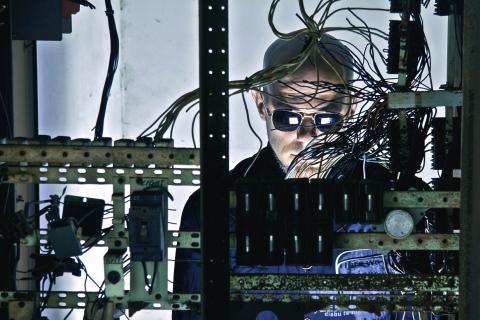A new scientific study released earlier this month shows large quantities of drugs — both legal and illegal — appearing in the Kenting water supply during the annual spring holiday weekend known as Spring Scream music festival. The study found large spikes of MDMA and ketamine in rivers at water treatment plants near the festival.
On Jan. 15, the Daily Mail ran the headline, “Are music festivals poisoning rivers? Experts discover spike in ecstasy and ketamine after public event that could affect aquatic life.” Other Web sites for science news and blogs followed suit, some pairing the story with random photos of people going wild at music festivals that were clearly not in Taiwan. A blog called BroBible ran the headline, “The Fish In Taiwan Are Getting F***ed Up On Ecstasy And Ketamine.”
The Taiwan study itself was titled “Impacts of Emerging Contaminants on Surrounding Aquatic Environment from a Youth Festival” and was published in Environmental Science and Technology. It was funded by the government and authored by a group of researchers in universities in Greater Kaohsiung, including Lee Chon-lin (李宗霖) of National Sun Yat-sen University.

Photo courtesy of Roughhausen
Lee and company tested water from 28 rivers and two waste water sites near Kenting over the last two years, with specific attention to spiking levels during the weekend around the annual Tomb Sweeping Day holiday.
Ketamine, a popular recreational drug, scored the highest concentration of any of the tested substances. During the holiday weekend, researchers found concentrations of ketamine as high as 138,000 nanograms/liter, followed by pseudoephedrine (44,667 ng/L), caffeine (13,633 ng/L), acetaminophen (8,433 ng/L), codeine (3967 ng/L), ibuprophen (1,500 ng/L) and MDMA (1267 ng/L). Concentrations of the drug MDMA, known as ecstasy or molly, went from 89 ng/L before the festival to 940 ng/L during the weekend, then rapidly dropped off again. The study argues that “the noteworthy presence of this compound might be due to MDMA abuse that coincided with the Spring Scream.”
However, the study wrongly confuses the holiday weekend with Spring Scream, one of four or five festivals happening that weekend. Though Spring Scream became Kenting’s first festival in 1995, it is now one of the area’s smaller events, with only a few thousand attendees each year of an estimated 600,000 visitors (according to a Tourism Bureau estimate).

Photo courtesy of Roughhausen
The drugs end up in the water supply after people take them because they have not been fully metabolized. So if you take a legal painkiller or an illegal recreational drug, when you urinate, those chemicals can end up in natural ecosystems. Waste water plants are not designed to remove pharmaceuticals, and other studies from overseas have shown drug spikes in water systems coinciding with the Super Bowl, Christmas and New Year’s.
So in a way, these studies give us the astounding results that whenever there is a big party, people tend to take drugs — duh. The recent Kenting study was highly focused on this question of drug use, rather than the more serious scientific question of whether these chemical concentrations pose risks to aquatic life.
According to the study, the greatest environmental risks were actually posed by antibiotics (ampicillin and tetracycline) and over-the-counter or prescription painkillers (acitaminophen and codeine) — substances for which the environmental risk to aquatic life was rated as “high.” The risks posed by MDMA and methamphetamine were rated as “moderate” and, despite its high concentration, the risk posed by ketamine was rated as “low.”

Photo courtesy of Roughhausen
The study also failed to find cocaine or heroin in the river sample, noting that they are highly metabolized and not easily detectable when expelled in urine. Cannabinol wasn’t detected either — which is weird, because we all know that urine tests get you busted for weed.
Since its publication, the study has created a certain image in the popular imagination, namely that people in Kenting are taking so many drugs that even the fish get high.
The reality is that Taiwanese routinely use many antibiotics and painkillers — and not just one weekend a year — that it is posing a credible environmental threat in water systems all around the island.
The Kenting study focuses on controlled substances from its very first sentence: “The youth festival...is notorious for the problems of drug abuse and addiction.” It closes with a final sentence expressing similar sentiments, saying the findings “implied that the problems of drug abuse and addiction during the youth festival, are consequent environmental issue are of concern.”
The problem is that drug use is a social-ethical question. Pollution is a scientific question. Confusing these issues does not do anyone any good. The impact of pollution on the environment is something that can be quantified. The supposed harm of drug use, however, is widely debated and not so clear cut.
Roughhausen’s Rock ‘n roll circus
The industrial dance music act Roughhausen will kick off their Rock ‘n Roll Circus with a collection of bizzarities tonight at Pipe Live Music. Aside from the music, there will be a firebreather, fire eater, contortionist, sword-swallowing musician, a Burlesque troupe, a drag troupe and a comedy act involving two drag queens dressed as Siamese twins.
“When I go abroad, I see this kind of stuff happening, with all these crazy non-music acts mixed in with performances,” says Jeff Stoddard of Roughhausen. “So bringing this to Taiwan is the idea behind Rock ‘N Roll Circus.”
Stoddard, a former guitarist for Front Line Assembly who once worked for Skinny Puppy, has been based in Taiwan for more than a decade. His fans are however scattered in industrial music scenes around the world and he makes his living by touring and remixing commercial music production.
Roughhausen will soon have a remix coming out on the debut album of Primitive Race, a new band featuring members of Ministry, Pigface and Marilyn Manson’s band. The act also just released a new single, Can’t Find My Mind, a cover of a Cramps song.
■ Roughhausen’s Rock ‘N Roll Circus is tonight 8pm at Pipe Live Music, 1 Siyuan St, Taipei City (台北市思源街1號) Tickets are NT$400 at the door.

In the March 9 edition of the Taipei Times a piece by Ninon Godefroy ran with the headine “The quiet, gentle rhythm of Taiwan.” It started with the line “Taiwan is a small, humble place. There is no Eiffel Tower, no pyramids — no singular attraction that draws the world’s attention.” I laughed out loud at that. This was out of no disrespect for the author or the piece, which made some interesting analogies and good points about how both Din Tai Fung’s and Taiwan Semiconductor Manufacturing Co’s (TSMC, 台積電) meticulous attention to detail and quality are not quite up to

April 21 to April 27 Hsieh Er’s (謝娥) political fortunes were rising fast after she got out of jail and joined the Chinese Nationalist Party (KMT) in December 1945. Not only did she hold key positions in various committees, she was elected the only woman on the Taipei City Council and headed to Nanjing in 1946 as the sole Taiwanese female representative to the National Constituent Assembly. With the support of first lady Soong May-ling (宋美齡), she started the Taipei Women’s Association and Taiwan Provincial Women’s Association, where she

Chinese Nationalist Party (KMT) Chairman Eric Chu (朱立倫) hatched a bold plan to charge forward and seize the initiative when he held a protest in front of the Taipei City Prosecutors’ Office. Though risky, because illegal, its success would help tackle at least six problems facing both himself and the KMT. What he did not see coming was Taipei Mayor Chiang Wan-an (將萬安) tripping him up out of the gate. In spite of Chu being the most consequential and successful KMT chairman since the early 2010s — arguably saving the party from financial ruin and restoring its electoral viability —

It is one of the more remarkable facts of Taiwan history that it was never occupied or claimed by any of the numerous kingdoms of southern China — Han or otherwise — that lay just across the water from it. None of their brilliant ministers ever discovered that Taiwan was a “core interest” of the state whose annexation was “inevitable.” As Paul Kua notes in an excellent monograph laying out how the Portuguese gave Taiwan the name “Formosa,” the first Europeans to express an interest in occupying Taiwan were the Spanish. Tonio Andrade in his seminal work, How Taiwan Became Chinese,